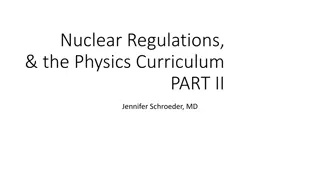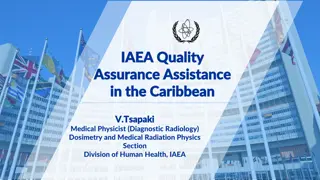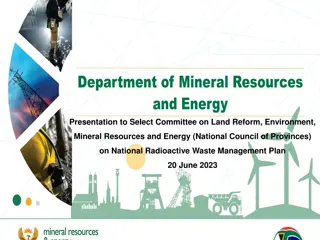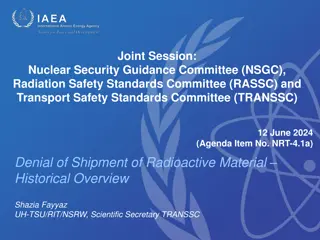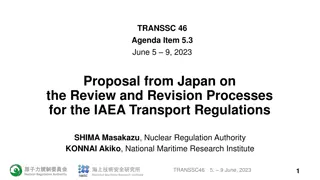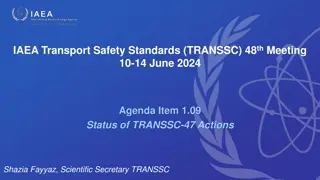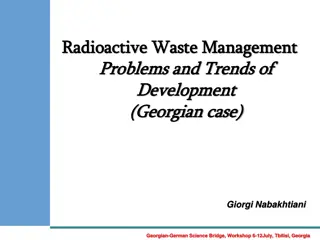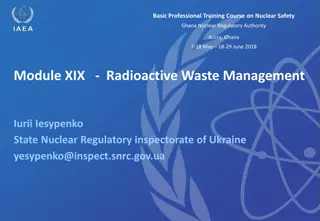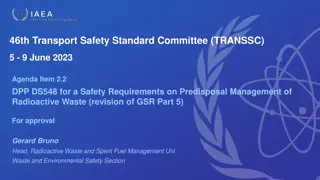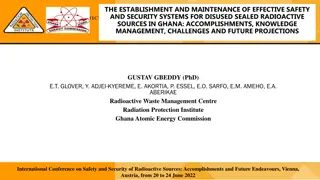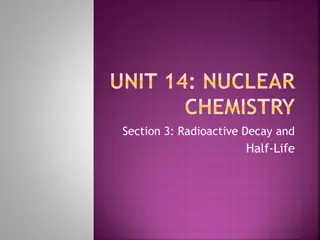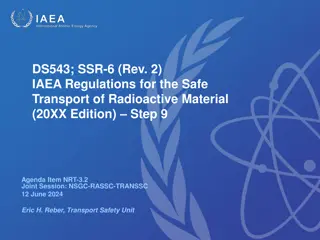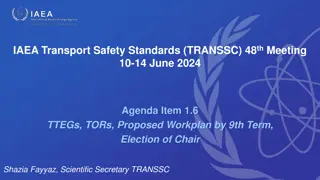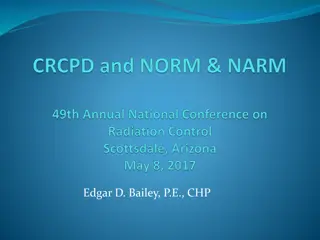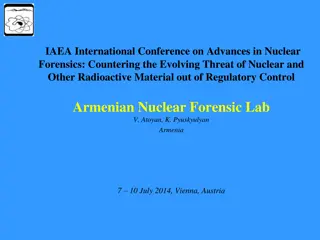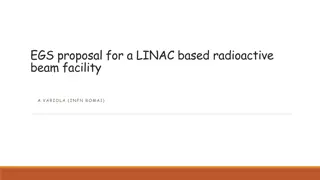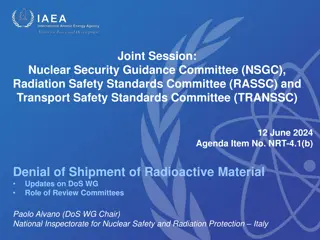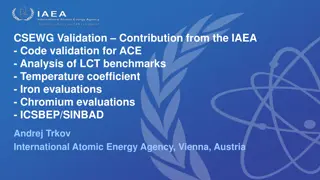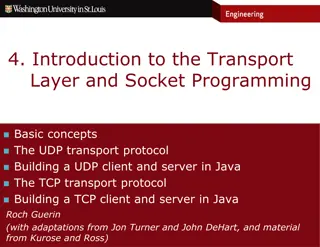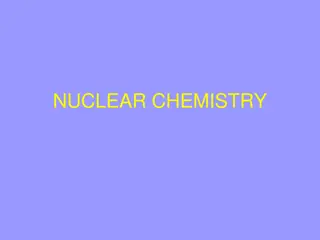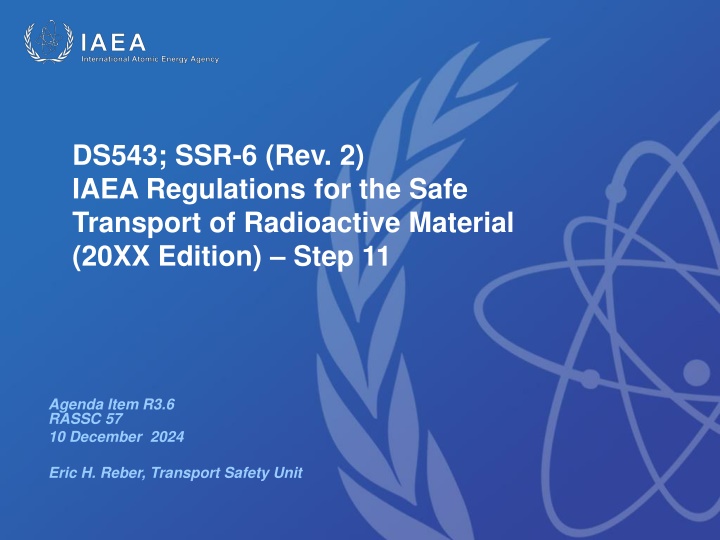
IAEA Regulations for Safe Transport of Radioactive Material
This document outlines the objectives and scope of the IAEA SSR-6 regulations, emphasizing the importance of ensuring safety during the transport of radioactive material. It provides insights into the international regulatory framework, review policies, and decision-making processes related to transport safety measures.
Uploaded on | 1 Views
Download Presentation

Please find below an Image/Link to download the presentation.
The content on the website is provided AS IS for your information and personal use only. It may not be sold, licensed, or shared on other websites without obtaining consent from the author. If you encounter any issues during the download, it is possible that the publisher has removed the file from their server.
You are allowed to download the files provided on this website for personal or commercial use, subject to the condition that they are used lawfully. All files are the property of their respective owners.
The content on the website is provided AS IS for your information and personal use only. It may not be sold, licensed, or shared on other websites without obtaining consent from the author.
E N D
Presentation Transcript
DS543; SSR-6 (Rev. 2) IAEA Regulations for the Safe Transport of Radioactive Material (20XX Edition) Step 11 Agenda Item R3.6 RASSC 57 10 December 2024 Eric H. Reber, Transport Safety Unit
Presentation Overview Objective and Scope of SSR-6 International regulatory framework for transport safety Review/Revision Policy Review Cycle Revision Cycle (SPESS) Step 8: Soliciting comments by Member States Step 9: Addressing comments by Member State Step 10: Second internal review of the draft publication Step 11: Second review of the draft publication by the Review Committees Update of the Q system/ correction of A1/A2values; Justification paper Decisions/Resolutions @TRANSSC 49 (18-22 November 2024) Request for second approval (Step 11)
Objective and Scope of SSR-6 The objective of SSR-6 (Rev. 1) is to establish requirements that must be satisfied to ensure safety and to protect people, property and the environment from harmful effects of ionizing radiation during the transport of radioactive material. SSR-6 (Rev. 1) applies to the transport of radioactive material by all modes on land, water, or in the air. Transport comprises all operations and conditions associated with, and involved in, the movement of radioactive material.
International Regulatory Framework for Transport Safety 193 signatories Incorporation of SSR-6 into the Model and Modal Regulations Model regulations for all dangerous goods 192 signatories Class 7 All modes Air Mail 167 signatories Sea Land transport Road, Rail and Inland Waterway Regional: MERCOSUR/MERCOSUL (4) ADR (54), RID (51), ADN (17) 4
Policy for reviewing and revising the Agencys Transport Regulations [Board of Governors (GOV/2005/31)] Transport regulations reviewed every two years the decision on the revision and publication will be made based on the assessment of TRANSSC/CSS If TRANSSC considers that a proposal for change stemming from a review cycle is sufficiently important for safety to necessitate publication as soon as possible, the Secretariat will initiate the revision process
Graphical Overview of the Review Process Proposals for change received by the Secretariat Initial review of proposals for change by TTEGs Recommendations by TTEGs to TRANSSC: accepted rejected impact on safety comments Recommendation / Decisions process for each individual proposal for change using the secondary set of questions in Annex 1 TRANSSC decisions: accepted rejected impact on safety Decision based on whether the aggregate of the accepted proposals would amount to a change in requirements that is important in terms of safety using the primary set of questions in Annex 1 TRANSSC decision on whether to revise SSR-6 (Rev. 1)
Overview of Proposals for Change 306 proposals received from Australia(3), Belarus(5), Belgium(1), Canada(10), France(70), Germany(11), IATA(12), ISO(3), Italy(7), Japan(17), Morocco(7), Oman(3), Pakistan(2), Russia(11), Sweden(15), Switzerland(28), WNTI(79), TIC(5), UK(8), USA(6) 294 unique proposals were assigned to primary TTEGs: TTEG Primary TTEG-C TTEG-OM TTEG-PPA TTEG-RP 37 177 62 18
Decision at TRANSSC 45 (Nov./Dec. 2022) to enter a Revision Cycle Based on the presentations and understanding of the TTEG recommendations to TRANSSC for each change proposal, coupled with the outcomes from the moderated discussions, roughly 75 change proposals were identified that would be addressed/acted on during the revision process. In summary, there was nearly unanimous support from the Member States to move into the revision of SSR-6 (Rev. 1).
Activity Start End 18 August 2022 STEP 1: Preparation of DPP July 2022 STEP 2: Internal review of the DPP (Approval by the Coordination Committee) 11 August 2022 18 August 2022 STEP 3: Review of the DPP by the Review Committees 26 August 2022 2 December 2022 STEP 4: Review of the DPP by the CSS (approval by CSS) 23 March 2023 23 May 2023 Revision Cycle Overview STEP 5: Development of revised manuscript of SSR-6 (Rev. 2) December 2022 24 July 2023 STEP 5*: Development of modified text for proposals that were designated as Accepted, but modified during T-45 December 2022 20 April 2023 STEP 5**: Review of revised text at TRANSSC 46 5 June 2023 9 June 2023 STEP 6: First internal review of SSR-6 (Rev. 2) (Approval by the Coordination Committee) 24 July 2023 24 August 2023 STEP 7: First approval of the draft publication by the Review Committees 31 August 2023 December 2023 STEP 8: Soliciting comments by Member States December 2023 May 2024 STEP 9: Addressing comments by Member States April 2024 July 2024 STEP 10: Second internal review of the draft publication (Approval by the Coordination Committee) July 2024 August 2024 STEP 11: Second review of the draft publication by the review Committee(s) (Approval of the draft) STEP 12: Editing of draft in MTCD and endorsement of the draft by the CSS, establishment by the Publications Committee and editing September 2024 December 2024 December 2024 April 2025 STEP 12*: Silence approval of the final edited text by TRANSSC STEP 13: Approval by the Board of Governors STEP 13*: Submittal of SSR-6 (Rev. 2) to UNECE STEP 14: Publication May 2025 June 2025 October 2025 October 2025 May 2025 September 2025 March 2026 January 2026
Step 8: Soliciting comments by Member States Note Verbale that solicited comments was issued on 3 January 2024 with a deadline of 8 May 2024 In accordance with the 2021 Transport Regulations Revision Quality Plan, only proposals that were submitted before the deadline of 18 March 2022 in response to the 5 November 2021 NV would be considered in the Revision Cycle. Table 2 of the draft SSR-6 (Rev. 2): included changes to A1/A2 values that are based on the results of the work of the TRANSSC s A1/A2 WG. Comments were requested concerning corrected A1/A2 values - Do you have any specific comments in relation to the justification for, or impact of, the proposed revised values? 285 Official comments received from Argentina (1), Australia (12), Belgium (3), Canada (13), Finland (1), France (62), Germany (54), Israel (3), Jamaica (5), Japan (33), Oman (9), Pakistan (16), Russia (9), Sweden (3), United Kingdom (19), United States (7), Switzerland (7), ISO (3), ISSPA (2), WNTI (23)
Step 9: Addressing official comments by Member States Draft resolution table and revised draft SSR-6 (Rev. 2) were developed during a consultancy meeting on 20 24 May 2024. In advance of the TRANSSC/RASSC meetings in June, files were uploaded to the respective folders of these committees for information . TRANSSC-48: Feedback received TTEG-C on RUS-5, and from TTEG- RP on A1/A2/Table 2 issues, i.e. ARG-1, JPN-03, AUS-1, CDN-04, GER- 8, FR-23, WNTI-02, USA-2 and UK-3. Concerning the proposed resolution of official comments, feedback was received from/ discussions held with representatives from: Germany, Israel, Japan, Switzerland, UK and WNTI Member States comments Resolution table and DS543 were revised, as appropriate, in response to the feedback received.
Step 10: Second internal review of the draft publication Comprehensive textual review of the draft performed by standards specialists in NSOC-SSDS in July 2024 All issues resolved internally Draft approved by the Coordination Committee on 22 August 2024
Step 11: Second review of the draft publication by the Review Committees 23 August 2024 Member States comments Resolution Table and Step-11 CLEAN/CHANGES TRACKED versions of DS543 uploaded for consideration by Review Committees Comments on resolution of the official comments were due by 8 October 2024 (no new proposals accepted); 172 comments received from Argentina- TRANSSC (1), Canada-TRANSSC (2), China-NUSSC (1), France-RASSC (32), France-TRANSSC (19), Germany-TRANSSC (11), India-NUSSC (8), India-WASSC (0), Indonesia-EPReSC (17), Japan-RASSC (2), Japan- TRANSSC (28), Morocco-TRANSSC (3), Switzerland-TRANSSC (9), UK- TRANSSC (7), USA-TRANSSC (1) and WNTI (21) 14 18 October 2024 consultancy meeting held to propose resolutions of comments; proposed to reject ~68% of the comments and accept/accept, but modify ~32% In accordance with Decision NRT-4, a reference to GSR Part 3 was added to para. 301. 22 October 2024 Step 11b resolution table and revised Step 11b CLEAN/CHANGES TRACKED versions of DS543 posted Step 11 approval will be/has been requested at the meetings of all Review Committees: WASSC: 29 October (Approved) EPReSC: 4 8 November (Approved) TRANSSC49 (Approved, with changes) & NUSSC (Approved): 18 22 November NSGC: 3 6 December (Approved w/ TRANSSC49 changes) RASSC: 9 13 December
Update of the Q system/ correction of A1/A2 values Background Q system used to derive A1/A2 values upper limit of radioactive material in a Type A package; other uses in SSR-6 because the values would produce equivalent radiological consequences Under the Q system, A1/A2 values are the quantities of a radionuclide that would produce the reference doses of 50 mSv (effective dose), 500 mSv (equivalent dose to the skin) and 150 mSv (equivalent dose to the lens of the eye) under five exposure scenarios, which are intended to represent potential doses resulting from accident conditions of transport Q system was last updated in the 1996 Edition of the Transport Regulations (SSR-6) Early Work to Re-evaluate the Q System and identification of problems As of 2013, reviews of the calculational methods used in the Q system were carried out by national organizations in UK, Germany, France and Japan. Various problems were identified, e.g. Q values and A1/A2 values are calculated using outdated input data inhalation dose coefficients are partly not consistent with the dose coefficients of ICRP 68, which were used in the current Q system some of the dose coefficients listed in SSG-26 seem to be calculated backwards from Q values listed in SSG-26; therefore, some A1/A2 values (especially for small dose coefficients) cannot be reproduced Q values have an artificial upper limit to 1000 TBq without justification or documentation determination of unlimited values for low specific activity (LSA) material is not thoroughly documented treatment of progenies is not always consistent and differs between the Q value exposure pathways some assertions (low ingestion dose, low impact of multiple pathway principle, arbitrary derivation of QA = QF = 104 QC for alpha emitters etc.) are not properly justified approximations are done in the calculation of energy deposition in the tissues An informal international working group was formed in 2013 to coordinate research on possible improved methods and associated results. This group became more formalized over the years and was later referred to as the A1/A2 WG and it is currently a part of the TRANSSC Technical Expert Group Radiation Protection. Report of the A1/A2 WG with corrected A1/A2 values is available in the Revision Cycle SSR-6 (Rev. 1) web folder. Corrected A1/A2 values were included in the version of SSR-6 that was distributed at Step 7 (Fall 2023) and in all subsequent versions including the one that was distributed for official comment by Member States on 3 January 2024.
Joint TRANSSC/RASSC WG Justification Paper Joint TRANSSC/RASSC WG formed in Dec. 2023 to consider: 1) details of the calculation methods of the A1/A2 Working Group 2) justification for the proposed changes to the A1 and A2 values 3) potential impact of revised A1 and A2 values on other IAEA safety standards Results/conclusions of the Joint WG were presented at the Joint NSGC/RASSC/TRANSSC meeting on 12 June 2024. RASSC and TRANSSC supported the establishment of a new joint WG to examine whether the correction of the A1/A2 values is justified in terms of potential impacts it may have in Member States RASSC and TRANSSC Secretariats agreed that, before deciding on the establishment of a new joint Working Group, a justification paper , which outlines the issues to be considered in deciding whether the incorporation of the corrected A1/A2 values into SSR-6 (Rev. 2) is justified, would be prepared and submitted to the Review Committees to aid them in their deliberations on this matter Justification paper was prepared by the Secretariats of TRANSSC and RASSC and was uploaded to the web folders of the various Review Committees
Justification paper Is there a justification to include the corrected A1/A2 values in the revision of SSR-6 (Rev. 1)? Significance of the safety impact Importance of adjusting the A1/A2 values to ensure that the quantities of radioactive material result in the specified doses under accident conditions as defined by the Q system Benefit of having an explicit and well-documented safety basis for all A1/A2 values Benefit of using the most up- to-date information and modelling techniques to calculate A1/A2 values Potential negative impact on the ability to economically transport certain radionuclides that may be used in emerging medical applications
Step 11 Decisions/resolutions of A1/A2/Table 2 Issues @ TRANSSC 49 A1/A2 values should be revised according to the findings of the A1/A2 WG 10-year transitional period was accepted with the view that it would allow sufficient time for the transport industry to adapt its operations to the new values Table 2 will be deleted, and its contents moved to a new appendix for user friendliness/flow of text Step 11 Other decisions/resolutions @ TRANSSC 49 The wording of para. 409(b)(i) will be: Tritiated water with an activity concentration of up to 0.8 TBq/L Para 414A and the title before para. 414A concerning the mixed packing of LSA and SCO will be deleted because of a conflict in the use of mixed packing in the Orange Book; also, the contents of para. 414A are redundant with other paras in SSR-6 Editorial: definitions / requirements in paras 415 & 416 Editorial: considering the nature of LSA and SCO that is being transported will be deleted from para. 522 or a conveyance will be added to paras 524 & 524(a), which deal with the calculation of the TI Figs 2 5 should be revised to add text to indicate that the 5 mm distance is approximate, and the 4 mm distance is a minimum. Para. 546(o) will be moved to a separate para. or NOTE
Step 11 Other decisions/resolutions @ TRANSSC 49 (cont) Small changes to paras 566(b), 573 and 822 concerning clarification of the conditions of exclusive use. Changes proposed in F-24 concerning para. 583 on actions to be taken when consignments cannot be delivered were rejected. Editorial: Simplification of text in para. 667 Rejected changes to para. 686 as proposed in Step11/JPN-20(TRANSSC) concerning the rounding of CSI No new manufacture of packagings to a package design meeting the 2018 Edition will take place after 31 December 2035 (instead of 31 December 2038).
Step 11 Other decisions/resolutions in Step11/@ TRANSSC 49 Step 11/JPN-07 (TRANSSC); para. 234 Current definition of radiation protection program (RPP) in 2018 Edition of SSR-6: Radiation protection programme shall mean systematic arrangements that are aimed at providing adequate consideration of radiation protection measures. Step 9/FR-12 proposed to add the words for the workers, the public and the environment to the end of this definition and this was accepted in Step 9. Step 11/JPN-07 (TRANSSC) proposed to delete the words and the environment from para. 234. Background/TRANSSC discussions Requirement 24 of GSR Part 3 requires arrangements in an RPP for occupational exposure. Para. 3.52 of GSG-7 states that protection of the public could be included within an RPP IAEA Safety Glossary only gives the definition of an RPP in para. 234 of SSR-6 Para. 3.2 of SSG-86 states that the scope of RPPs for transport is protection of workers and the public It is unclear what practical measures could be included in an RPP regarding protection of the environment Para. 104 on the objective of SSR-6 mentions protection of people, property and the environment in the context of EPR; also noted that the fundamental safety objective refers to the protection of the environment As a consensus could not be achieved, TRANSSC49 agreed to keep the current wording in the 2018 Edition and to inform RASSC of the issue.
Harmonization of the contents/structure of SSR-6 with IAEA Safety Standards & UNOB Article III.A.6 of the Agency s Statute: The Agency is authorized: To establish or adopt, in consultation and, where appropriate, in collaboration with the competent organs of the United Nations and with the specialized agencies concerned, standards of safety UN Economic and Social Council in Resolution 724 (XXVIII) C.3(g) (17 July 1959) expressed the desire of the Council that the Agency be entrusted with the drafting of recommendations on the transport of radio-active substances, provided that they are consistent with the framework and general principles of recommendations of the Committee of Experts on the Transport of Dangerous Goods of the UN, and that they are established in consultation with the UN and the specialized agencies concerned Style/structure/terminology/ concepts of the of the UN Orange Book and other regulatory instruments of the international regime for the safe transport of dangerous goods Agency/Safety Standards style/structure/terminology/ concepts Proposals aimed at harmonization with IAEA Safety Standards Series and with the UNOB are handled on a case-by-case basis. Factors to consider, e.g.: Terminology in UNOB, e.g. competent authority vs. regulatory body Generally applicable requirements of the UNOB, e.g. training requirements Audience familiarity with IAEA publications; SSR-6 has certain stand alone aspects UNOB requirements are detailed and prescriptive vs. overarching requirements in SS Certain GSR Part 3 definitions are not usable in international transport, e.g. radioactive material
Action requested of the Committee Step 11c: The Committee is requested to approve DS543 to move to Step 12: Endorsement by CSS and editing of draft publication in MTCD

